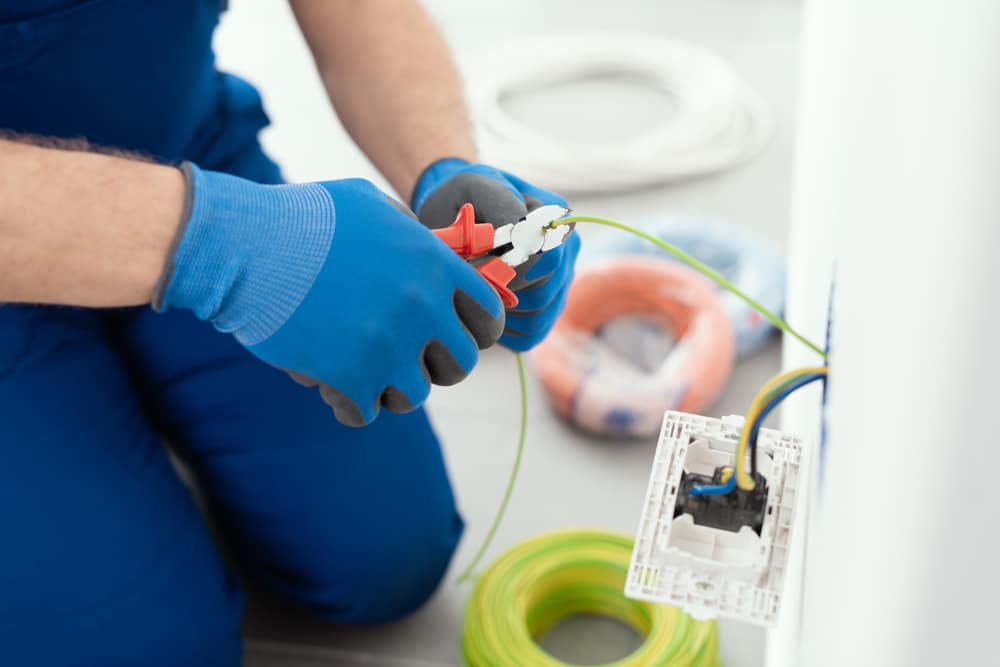Your home’s electrical system is like a heart, powering everything from your lights to your refrigerator, your HVAC system, and more. Having a basic understanding of how this system works can help you steer clear of problems and keep critical components in good condition.
Here’s what to know about household electrical systems and when you should reach out to a qualified Boston electrician for support.

How Does My Electrical System Work?
Your electrical system works by receiving power from an external source and channeling it through a series of wires, outlets, and switches to power things in your home. Most often, homeowners are connected to the electrical grid, but you can also use alternative energy sources like solar power.
Once the electricity comes into your home, a circuit breaker is used to divide the energy into portions for each area of your space. This prevents too much power from going into any one room or appliance. The result is instant electricity when you turn on a light or plug something into a wall outlet.
5 Residential Electrical Problems You Might Encounter
The most common household electrical problems include things like:
1. Tripped Circuit Breakers
When your circuit breakers trip, this is a sign that there’s too much power flowing through your electrical wires in a certain area of your home. Your breaker may flip when you have too many appliances being powered from a single circuit or when there’s a problem with your wiring. You can reset the breaker, but if this continues to happen, you should call an electrician.
2. Old or Damaged Wiring
Boston has a lot of charming, old Colonial homes, but these often have outdated electrical wiring that can even be hazardous under the right conditions.
Look for things like exposed wires, electric sparks you can see, and the odor of melting or burning plastic. These can indicate critical problems that need immediate repairs, and you may need to stop using outlets, lights, and powered appliances in the affected space until the issue is fixed.
3. Flickering Lights
Flickering lights aren’t just an annoying problem to ignore — they’re often a sign of a bigger issue at play. For example, you could have a loose connection somewhere or rodent-chewed wiring that poses a fire hazard. If your lights flicker or dim when you use appliances like your hair dryer or vacuum cleaner, this might indicate that your house doesn’t have enough power for everything you need.
4. Rising Energy Bills
Unexpectedly high energy bills can throw a wrench in your budget and could indicate a problem with your electrical system. Old, inefficient wiring and outdated appliances can force your system to work harder than it needs to, increasing the amount of power you consume without giving you any additional benefits.
You could also have poor insulation or drafty windows that are affecting your heating and cooling system. Anytime you notice that your bill is higher than normal, it’s a good idea to check with your electric company and get your electrical system assessed by a professional.
5. Warm Wall Outlets or Switches
Outlets that are yellowed or warm to the touch is usually an indication that too much power is going to the outlet. It can also be a sign that there’s an exposed wire or loose connection. This also applies to light switches and can lead to an electrical fire if not fixed.
Can I DIY My Own Home Electrical Repairs?
While some electrical repairs are relatively simple, like replacing an outlet cover, most of them involve live electricity and can be very dangerous.
Even minor slip ups can cause major problems, so unless you are an electrician yourself, it’s usually best to leave repairs and maintenance for this critical system to the professionals. Licensed electricians are specifically trained to mitigate risks and are insured in case anything goes wrong.
When to Call a Licensed and Certified Boston Electrician
If you’re having problems with your home electric, don’t wait to call a professional. N.E.T.R., Inc. can help you troubleshoot problems with your power and will get you back up and running smoothly as fast as we can. Reach out to us today by calling (781) 933-6387 or filling out our online contact form so we can get the ball rolling.

